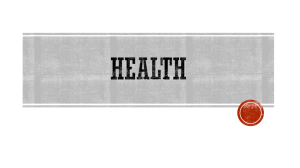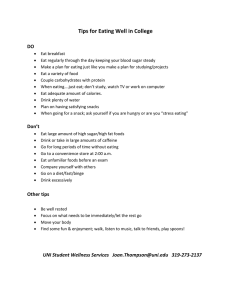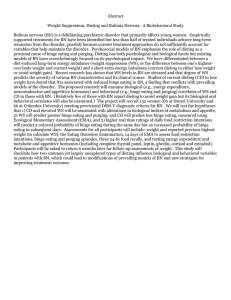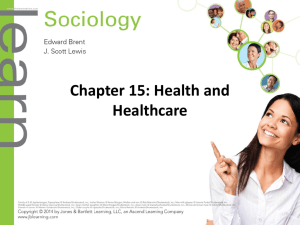College students’ definitions of an “eating binge” differ as
advertisement
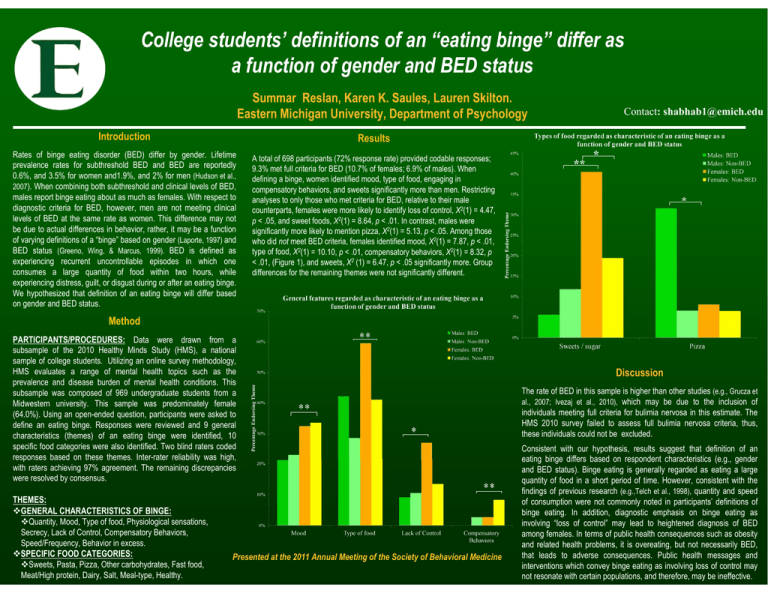
College students’ definitions of an “eating binge” differ as a function of gender and BED status Summar Reslan, Karen K. Saules, Lauren Skilton. Eastern Michigan University, Department of Psychology Introduction Results Rates of binge eating disorder (BED) differ by gender. Lifetime prevalence rates for subthreshold BED and BED are reportedly 0.6%, and 3.5% for women and1.9%, and 2% for men (Hudson et al., 2007). When combining both subthreshold and clinical levels of BED, males report binge eating about as much as females. With respect to diagnostic criteria for BED, however, men are not meeting clinical levels of BED at the same rate as women. This difference may not be due to actual differences in behavior, rather, it may be a function of varying definitions of a “binge” based on gender (Laporte, 1997) and BED status (Greeno, Wing, & Marcus, 1999). BED is defined as experiencing recurrent uncontrollable episodes in which one consumes a large quantity of food within two hours, while experiencing distress, guilt, or disgust during or after an eating binge. We hypothesized that definition of an eating binge will differ based on gender and BED status. A total of 698 participants (72% response rate) provided codable responses; 9.3% met full criteria for BED (10.7% of females; 6.9% of males). When defining a binge, women identified mood, type of food, engaging in compensatory behaviors, and sweets significantly more than men. Restricting analyses to only those who met criteria for BED, relative to their male counterparts, females were more likely to identify loss of control, X2(1) = 4.47, p < .05, and sweet foods, X2(1) = 8.64, p < .01. In contrast, males were significantly more likely to mention pizza, X2(1) = 5.13, p < .05. Among those who did not meet BED criteria, females identified mood, X2(1) = 7.87, p < .01, type of food, X2(1) = 10.10, p < .01, compensatory behaviors, X2(1) = 8.32, p < .01, (Figure 1), and sweets, X2 (1) = 6.47, p < .05 significantly more. Group differences for the remaining themes were not significantly different. Contact: shabhab1@emich.edu ** * Method PARTICIPANTS/PROCEDURES: Data were drawn from a subsample of the 2010 Healthy Minds Study (HMS), a national sample of college students. Utilizing an online survey methodology, HMS evaluates a range of mental health topics such as the prevalence and disease burden of mental health conditions. This subsample was composed of 969 undergraduate students from a Midwestern university. This sample was predominately female (64.0%). Using an open-ended question, participants were asked to define an eating binge. Responses were reviewed and 9 general characteristics (themes) of an eating binge were identified, 10 specific food categories were also identified. Two blind raters coded responses based on these themes. Inter-rater reliability was high, with raters achieving 97% agreement. The remaining discrepancies were resolved by consensus. THEMES: GENERAL CHARACTERISTICS OF BINGE: Quantity, Mood, Type of food, Physiological sensations, Secrecy, Lack of Control, Compensatory Behaviors, Speed/Frequency, Behavior in excess. SPECIFIC FOOD CATEGORIES: Sweets, Pasta, Pizza, Other carbohydrates, Fast food, Meat/High protein, Dairy, Salt, Meal-type, Healthy. Presented at the 2011 Annual Meeting of the Society of Behavioral Medicine Discussion The rate of BED in this sample is higher than other studies (e.g., Grucza et al., 2007; Ivezaj et al., 2010), which may be due to the inclusion of individuals meeting full criteria for bulimia nervosa in this estimate. The HMS 2010 survey failed to assess full bulimia nervosa criteria, thus, these individuals could not be excluded. Consistent with our hypothesis, results suggest that definition of an eating binge differs based on respondent characteristics (e.g., gender and BED status). Binge eating is generally regarded as eating a large quantity of food in a short period of time. However, consistent with the findings of previous research (e.g.,Telch et al., 1998), quantity and speed of consumption were not commonly noted in participants’ definitions of binge eating. In addition, diagnostic emphasis on binge eating as involving “loss of control” may lead to heightened diagnosis of BED among females. In terms of public health consequences such as obesity and related health problems, it is overeating, but not necessarily BED, that leads to adverse consequences. Public health messages and interventions which convey binge eating as involving loss of control may not resonate with certain populations, and therefore, may be ineffective. College students’ definitions of an “eating binge” differ as a function of gender and BED status Summar Reslan, Karen K. Saules, Lauren Skilton. Eastern Michigan University, Department of Psychology Contact: shabhab1@emich.edu References • Greeno, C.G., Wing, R.R., & Marcus, M.D. (1999). How many donuts is a “binge”? Women with BED eat more but do not have more restrictive standards than weight-matched non-BED women. Addictive Behaviors, 24(2), 299-303. • Grucza, R.A., Przybeck, T.R., Cloninger, C.R. (2007). Prevalence and correlates of binge eating disorder in a community sample. Comprehensive Psychiatry, 48(2), 124-131. • Hudson, J.I., Hiripi, E., Pope, H.G., & Kessler, R.C. (2007). The prevalence and correlates of eating disorders in the national comorbidity survey replication. Biological Psychiatry, 61, 348-358. • Ivezaj, V., Saules, K.K., Hoodin, F., Alschuler, K., Angelella, N., Collings, A.S., Saunders-Scott, D., Wiedemann, A. (2010). The relationship between binge eating and weight status on depression, anxiety, and body image among a diverse college sample: A focus on bi/multiracial women. Eating Behaviors, 11, 18-24. • Laporte, D.J. (1997). Gender differences in perception and consequences of an eating binge. Sex Roles, 36(7/8), 479-489. • Telch, C.F., Pratt, E.M., & Niego, S.H. (1998). Obese women with binge eating disorder define the term binge. International Journal of Eating Disorders, 24, 313-317.
